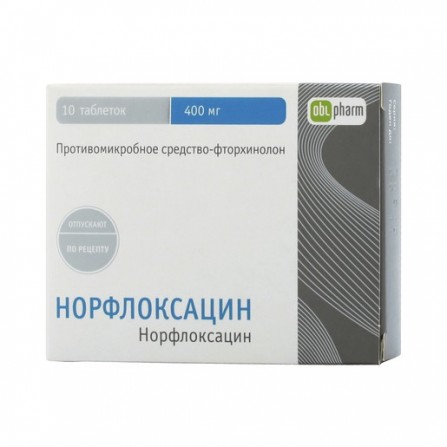Norfloxacin-OBL 400mg N10 Coated Tablets
Condition: New product
1000 Items
Rating:
Be the first to write a review!

More info
Active ingredients
Norfloxacin
Release form
Pills
Composition
1 tablet contains: Norfloxacin 400 mg
Pharmacological effect
Antimicrobial synthetic agent of the fluoroquinolone group of broad-spectrum. It has a bactericidal effect. Suppressing DNA gyrase violates the process of DNA supercoiling. Highly active against most gram-negative bacteria: Escherichia coli, Salmonella spp., Shigella spp., Proteus spp., Morganella morganii, Klebsiella spp. (including Klebsiella pneumoniae), Enterobacter spp., Serratia spp., Citrobacter spp., Yersinia spp., Providencia spp., Haemophilus influenzae, Pseudomonas aeruginosa, Neisseria gonorrhoeae, Neisseria meningitidis. It is active against some gram-positive bacteria (including Staphylococcus aureus). Anaerobic bacteria are resistant to norfloxacin, insensitive to Enterococcus spp. and Acinetobacter spp. Resistant to β-lactamase.
Pharmacokinetics
When ingestion is absorbed about 30-40%, food intake reduces the rate of absorption. Binding to plasma proteins is 14%. Norfloxacin is well distributed in the tissues of the urogenital system. It penetrates the placental barrier. About 30% is excreted in the urine unchanged.
Indications
Infections caused by microorganisms susceptible to norfloxacin: urinary tract infections (except acute and chronic pyelonephritis complicated), prostatitis, uncomplicated gonorrhea.
Contraindications
Hypersensitivity. Tendonitis, tendon rupture caused by taking fluoroquinolones (including a history of). Pregnancy, lactation period, children's age, deficiency of glucose-6-phosphate dehydrogenase.
Precautionary measures
On the part of the digestive system: nausea, heartburn, anorexia, diarrhea, abdominal pain. From the side of the central nervous system: headache, dizziness, fatigue, sleep disorders, irritability, anxiety. On the side of the urinary system: interstitial nephritis.
Use during pregnancy and lactation
Norfloxacin is contraindicated during pregnancy and lactation (breastfeeding), because in experimental studies it was found that it causes arthropathy.
Dosage and administration
With urinary tract infections - 400 mg 2 times a day for 7-10 days; with uncomplicated cystitis - 3-7 days; with chronic recurrent urinary tract infections - up to 12 weeks. With acute bacterial gastroenteritis - 5 days. In acute gonococcal urethritis, pharyngitis, proctitis, cervicitis - once 800 mg. With typhoid fever - 400 mg 3 times a day for 14 days. For the prevention of sepsis - 400 mg 2 times a day.For the prevention of bacterial gastroenteritis - 400 mg / day. For the prevention of travelers' diarrhea - 400 mg / day for 1 day before departure and during the entire period of the journey (no more than 21 days). For the prevention of recurrence of urinary tract infections - 200 mg / day. In patients with impaired renal function with CC more than 20 ml / min, correction of the dosage regimen is not required. When CC is below 20 ml / min (or serum creatinine concentration more than 5 mg / 100 ml) and patients on hemodialysis, 1/2 of the therapeutic dose is prescribed 2 times a day or the full dose 1 time per day.
Side effects
From the central nervous system (CNS) dizziness, headache, tingling in the fingers, drowsiness, anxiety, depression, insomnia, sleep disturbance. From the digestive system nausea, abdominal pain, anorexia, diarrhea, pain in the rectum or anus, constipation, dyspepsia, flatulence, vomiting, dryness of the oral mucosa, heartburn, unformed stools, bitter taste in the mouth, ulceration of the oral mucosa, itching of the anus. pruritus, rash, erythema, urticaria. For sensory organs, blurred visual perception. On the musculoskeletal system, bursitis, swelling of the hands and feet. systems of renal colic. Laboratory indicators of increased activity of AST, ALT, alkaline phosphatase, LDH, proteinuria, decreased hematocrit and Hb, increased concentration of urea in the blood, hypercreatininemia, glucosuria. oradka, chills, chest pain, dysmenorrhea, edema, allergic reactions.
Interaction with other drugs
With simultaneous use of norfloxacin with warfarin increases the anticoagulant effect of the latter. With the simultaneous use of norfloxacin with cyclosporine, an increase in the concentration of the latter in the blood plasma is observed. While taking Norfloxacin and antacid agents or drugs containing iron, zinc, magnesium, calcium or sucralfate, absorption of norfloxacin is reduced due to the formation of complexones with metal ions (the interval between their intake should be at least 4 hours).When taken simultaneously, Norfloxacin reduces theophylline clearance by 25%, therefore, with simultaneous use, reduce the dose of theophylline. Simultaneous administration of norfloxacin with drugs that have the potential ability to reduce blood pressure, can cause a sharp decrease. In this regard, in such cases, as well as with the simultaneous introduction of barbiturates, anesthetics, heart rate, blood pressure, ECG indicators should be monitored. Simultaneous use with drugs that reduce the epileptic threshold may lead to the development of epileptiform seizures. Reduces the effect of nitrofurans.
special instructions
It should be used with caution in patients with epilepsy, convulsive syndrome of a different etiology, with severe impaired renal and hepatic function. During treatment, patients should receive a sufficient amount of fluid (under the control of diuresis). Norfloxacin should be taken no less than 2 hours before or 2 hours after taking antacids or preparations containing iron, zinc, magnesium, calcium or sucralfate.



